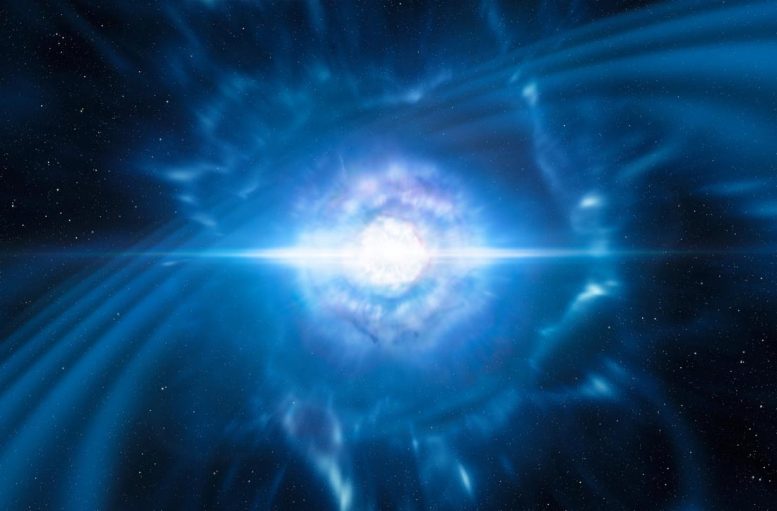
Artist’s impression of merging neutron stars. Credit: James Josephides, Swinburne University of Technology
On the 17th of August 2017, the world of astronomy bore witness to an unprecedented event: the LIGO/Virgo collaboration recorded the vibrations of a merging pair of neutron stars. The event was observed in electromagnetic waves across the spectrum, from gamma rays, optical, ultraviolet, infrared, through to radio. The Universe was being seen and heard simultaneously, for the very first time.
Astronomers have discovered binary neutron stars before, as a part of pulsar surveys—pulsars are rapidly rotating neutron stars. They’re the size of a city (~10km radius); have extremely strong magnetic fields; rotate up to 1000 times per second; and emit beams of radiation along their poles. As they spin, these beams may point towards the Earth like a lighthouse, allowing them to be observed by radio telescopes.
Due to their extremely periodic motion, pulsars can serve as accurate clocks to test Einstein’s theory of General Relativity. All pulsars are neutron stars but not vice versa. Radio telescopes have detected pulsars in binary systems with other neutron stars (and in one case, another pulsar). Given the dynamic and mysterious nature of binary neutron stars, a team of researchers from the ARC Centre of Excellence for Gravitational Wave Discovery (OzGrav) decided to study their formation, evolution and merger, examining the underlying uncertainties. In trying to investigate these mechanisms, astronomers’ observations are clues to solve the puzzle.
In the study, led by OzGrav PhD student Debatri Chattopadhyay, the team used COMPAS—a population synthesis code (co-developed by OzGrav) that generates and evolves a group of isolated binary stars to create millions of isolated binaries in the supercomputer OzSTAR. It is assumed every neutron star is born as a pulsar in a supernova (a powerful and luminous stellar explosion), but magnetized pulsars, with their misaligned rotation and radio emission, slow down over time. Losing its rapid rotational motion, slow pulsars become less magnetized and eventually die; however, they can be revived with the help of their partner star.
‘Under specific conditions, matter from the still-evolving companion star may fall onto the pulsar and refuel its rotation. These “zombie pulsars” start to emit radio waves again, spinning fast, but with much lower surface magnetization,’ explains Chattopadhyay.
Implementing the physics of pulsar evolution in COMPAS, the researchers modeled different binary neutron star systems and found a ‘best-fit’ model, analyzed in both radio and gravitational waves.
‘We underline how the “radio alive”’ pulsar-neutron star binaries may have a different signature than double neutron stars, decipherable from only gravitational wave measurable parameters,’ says Chattopadhyay.
These findings provide a better understanding of binary pulsar evolution and their formation channels. The COMPAS code can also be used to study other exotic binary systems, like pulsar-black holes or millisecond pulsar-white dwarfs.
Reference: “Modelling double neutron stars: radio and gravitational waves” by Debatri Chattopadhyay, Simon Stevenson, Jarrod R Hurley, Luca J Rossi, Chris Flynn, 19 March 2020, Monthly Notices of the Royal Astronomical Society.
DOI: 10.1093/mnras/staa756








 User Center
User Center My Training Class
My Training Class Feedback
Feedback












Comments
Something to say?
Login or Sign up for free